Botanical Name: Pinus succinefera fossil Common name: Fossil Amber, Kharuubaa Read More
|
Botanical Name: |
Pinus succinefera fossil |
|
Common name: |
Fossil Amber, Kharuubaa |
|
Plant family: |
Pinaceae |
|
Genus: |
Pinus |
|
Appearance/Color: |
Viscous liquid having pale yellow to
brownish appearance |
|
Odor: |
Warm and smoky odor |
|
Blends With: |
Geranium,
Pine Cedarwood, clove, orange, rose and benzoin |
|
Origin |
India |
|
Source |
Fossilized
Resin |
|
Method of
Extraction |
Solvent
Extraction |
Amber
Oil has a very vitalizing & tonic effect and helps in activating movement
of Kundalini & electrical flow throughout the body. The original source of
resin from which the oil is processed is a tree related to Jatoba - the
Brazilian energy & sexual tonic.
Fossilized
sap of the giant prehistoric conifer 'Pinus Succinfera', Amber Essential Oil is
estimated to be between 40 and 60 million years old, its' use as a trading
commodity dates back to 8000 BC. Amber has had various names down the
centuries, These include, 'Sunstone', 'Stone of victory', 'Adornment of the
daughters of Rome', and 'Gold of the North'. Its English name derives from
Ancient Arabia where it was burnt as incense and was known as 'anbar' or
'ambar'. The crude essential oil is obtained by dry distillation of the fossil
resin.
Amber
essential oil, Pinus succinefera fossil, has been credited with numerous
beneficial properties both physical and spiritual. The Ancient Romans and
Greeks used Amber essential oil to cure ailments such as asthma, rheumatism and
internal problems. It's purported healing powers have extended to epilepsy,
jaundice, kidney and bladder complaints and even the plague. It has also been
used as an aphrodisiac and to guard against witchcraft. It is now believed to
be a good source of beneficial negative ions when worn close to or on the skin.
Amber essential oil, Pinus succinefera
fossil, has been credited with numerous beneficial properties both physical and
spiritual. The Ancient Romans and Greeks used Amber essential oil to cure
ailments such as asthma, rheumatism and internal problems. It's purported
healing powers have extended to epilepsy, jaundice, kidney and bladder
complaints and even the plague. It has also been used as an aphrodisiac and to
guard against witchcraft. It is now believed to be a good source of beneficial
negative ions when worn close to or on the skin.
COMMON
USAGE
·
Improves
Circulation
·
Relieves
Anxiety
·
Jaundice
·
Epilepsy
·
Aphrodisiac
TOXICOLOGICAL
INFORMATION
Safety summary
·
Hazards: Skin sensitization (low risk).
·
Maximum adult daily oral dose: 368 mg
·
Maximum dermal use level: 2%
Safety advice:
Organ-specific
effects
·
Adverse skin reactions: No data
·
Reproductive toxicity: No
data
Systematic
effects
·
Acute toxicity: No information found
·
Carcinogenic/ anticarcinogenic
potential:
No data
ECOLOGICAL
INFORMATION
·
Ecotoxicity: very toxic to aquatic environment.
·
Bioaccumulation: Bioaccumulation unlikely
·
Mobility in soil: No data available
·
Persistence and degradability: No data available
·
Biodegradation: expected
·
PBT and vPvB assessment: No data available










